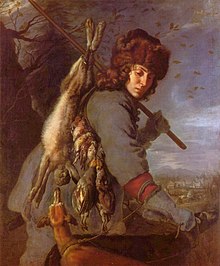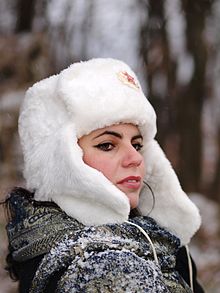Ushanka
The Ushanka ( Russian ушанка Ushanka ) is also for extremely cold weather conditions suitable headgear . It was adapted to different needs in different versions. The name Ushanka (from Russian у́ши uschi , German `` ears '' ) indicates the possibility of folding down the flaps sewn into the edge of the hat and turned upwards to protect the ears and neck, depending on the design, also the forehead part. The ushanka is very popular with private individuals, various professional groups and organizations. In terms of external appearance, the ushanka has become the epitome of Russian headgear.
The term "Schapka" (Russian шапка ), which is widespread in English-speaking countries as well as in Germany , simply means cap, so the word does not fully reflect the meaning. For the military headgear of the same name, see Tschapka .
description

The ushanka is an independent type of hat . The classic basic shape of the headgear has been preserved since its creation. The body of the hat is adapted to the shape of the head. In contrast to the so-called mountain hat , the military version is designed so that it can also be worn under a steel helmet . That's why there is no cap. A soft, all-round neck, ear and cheek protection can be folded down on the side and back of the cap. This protection, mostly made of fur, is made so wide that it covers the cheeks and at least parts of the neck down over the ears. In the front area of the hat there is a mostly sewn-on, unusable decorative flap in modern models. On this decorative flap, which covers the forehead, a badge is attached to military and often to other professional groups.
Ushankas are often made of fur , from inexpensive rabbit fur , sheep , muskrat and fox to high-quality mink or even sable fur , there are also versions in artificial fur , leather , artificial leather , wool felt and cord . In Russia, civil models made of faux fur are mainly sold to tourists. For a few years now, a wide range of synthetic materials such as thermal fabrics have also been used for affordable, fashionable variants. In most cases, at least two of the materials mentioned are used in every hat. In this case, the opened parts that adorn the hat are usually made of fur or faux fur. When thrown down, they lie warm to the head. Straps made of fabric or leather, now also with Velcro, allow the flaps under the chin or on the top of the hat to be connected.
In Russia, it is considered unmanly to wear the ushanka's ear flaps down. There are trompe l'oeil -Uschankas manufactured with firmly sewn, serving only as an ornament ear flaps. There are also variants in which a knitted waistband can be used for ear protection, thus maintaining the preferred look with flaps closed at the top.
history
Possible early forms
Cap shapes with flexible side flaps as additional protection can already be found in late medieval and baroque depictions outside of Russia. The ushanka goes back to the Second World War .
1918-1945
In 1918, during the Russian Civil War , the so-called Kolchakovka was introduced into the White Army , which enjoyed great popularity and is considered to be the model of the modern Ushanka. The White Army lost the war, and the Kolchakovka found no use in the Red Army . The Russian-Finnish winter war of 1939/40, in which thousands of Russian soldiers died of frostbite and hunger for lack of suitable equipment and organization, made it necessary to rethink the entire uniformity of the Red Army, which was only introduced in 1936. The consequences drawn from this included the replacement of the Budjonowka with the newly developed Ushanka, which became part of the Soviet winter uniforms from 1940. Officers wore ushankas made of real fur; For the soldiers and non-commissioned officers, cheaper models with imitation fur made of wool plush and another layer of fabric called "fish fur" were made from the beginning. Instead of a conspicuous big red star like the Budjonowka, there was only a small red star made of enamel for the new hat , which was attached to the forehead flap. From the Second World War until the end of the Red Army, cheaper versions of the badge made of khaki-painted metal were also issued.
Like other Soviet cold protection clothing, the ushanka quickly became popular with German soldiers as an unofficial item of equipment on the Russian front, as Germany had not worked on effective army clothing for very low temperatures for a long time. It was not until winter 1943/44 that suits corresponding to the Russian climate were issued. Due to the war and the sometimes complicated manufacturing techniques, only too few of these clothing found their way to the front. In 1943/44, the German side began to copy the Ushanka.
The Finnish armed forces use a hat similar to that of a ushanka. It has been part of the uniform there for longer than the ushanka of the Soviet-Russian army . In its version from 1939, this headgear is still worn today as the Turkislakki M39 .
After 1945

Master furrier Rüdiger in Leipzig received an allocation of rabbit fur and worked from it in Ushankas (around 1980)

As with the trench coat , for example , the ushanka was no longer only used as a uniform after 1945, but also copied for civilian use.
Despite the positive experiences, the Ushanka did not find entry into the West German Bundeswehr or other West German authorities and organizations after the Second World War . Only in the civil sector did it enjoy a certain popularity. A similar picture emerged in other NATO countries during the Cold War , which is certainly due to ideological reasons. In contrast, the ushanka was and is worn in various versions in many states of the former Warsaw Pact and other communist countries such as China and North Korea . During the 1980s, the ushanka became more common and popular in the west as well. Out of ignorance, the almost identical Finnish Turkislakki was usually referred to as "Ushanka". In the north of the USA , the hat was widely accepted by Eastern European immigrants and is used by some American and Canadian police stations, among others. The ushanka (without badge) was introduced to the Danish army in 1984 as the M / 84 winter hat.
In the Russian army , successor models of the Ushanka M40 were part of the winter clothing of officers and men until 2014. As the Russian Defense Minister Sergei Shoigu announced in early 2013, the ushanka will be retired from 2014 and will no longer be part of the Russian winter uniform.
The already mentioned Finnish Turkislakki M39 is still worn by the men, cadets and officers of the Finnish armed forces. A slightly modified variant, the Turkislakki M87, is also part of the equipment. An adapted and modernized version of the Turkislakki, the Turkislakki M05 , is used for the combat suit introduced in 2005 .
Web links
Individual evidence
- ↑ a b c Laurent Mirouze: Infantrymen of the Second World War. Karl-Heinz Dissberger, Düsseldorf, ISBN 3-924753-27-X , p. 26.
- ↑ Steven Zaloga : Red Army of the Great Patriotic War 1941-5. Osprey Publishing, 1989, ISBN 0-85045-939-7 , p. 43.
- ^ Mathias Färber: Second World War. Unipart-Verlag, Stuttgart 1990, ISBN 3-8122-3001-1 , p. 556.
- ↑ Andrew Steven, Peter Amodio: Waffen SS - Uniforms in Color. 2nd edition, Karl-Heinz Dissberger, Düsseldorf 1992, ISBN 3-924753-44-X , p. 58.
- ↑ Andrew Steven, Peter Amodio: Waffen SS - Uniforms in Color. 2nd edition, Karl-Heinz Dissberger, Düsseldorf 1992, ISBN 3-924753-44-X , p. 63.
- ↑ Jari Leskinen, Antti Juutilainen: Jatkosodan pikkujättiläinen. Söderström, Helsinki 2005, ISBN 978-951-0-28690-6 . P. 90; www.puolustusvoimat.fi, Uniforms for the Finnish Armed Forces. Finnish Army website; accessed on December 6, 2014 ( Memento of the original from December 6, 2014 in the Internet Archive ) Info: The archive link was inserted automatically and has not yet been checked. Please check the original and archive link according to the instructions and then remove this notice.
- ↑ de.ria.ru; Security and Military - Russian Army says goodbye to legendary Shapka; RIA Novosti news agency announcement; Retrieved December 6, 2014.
- ↑ www.puolustusvoimat.fi, M05 combat uniform of the Finnish armed forces; Finnish Army website; Retrieved on December 6, 2014 ( Memento of the original from December 9, 2014 in the Internet Archive ) Info: The archive link was inserted automatically and has not yet been checked. Please check the original and archive link according to the instructions and then remove this notice.








